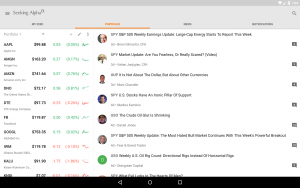As Head of Mobile R&D in Seeking Alpha I’m being asked constantly by developers and product managers alike if we can implement a feature on both the phone and the tablet.
For example, here is the Seeking Alpha Android application showing the portfolio page on a phone and on a tablet:
Tag Archives: Android
Android Dependency Assassin – Part 1: Butter Knife
A good knife man know his tools. The dagger is sharp and fierce while the butter knife is blunt and mellow. The sword is noble and swift while the Swiss army knife is handy and quick.
This post series will focus on reducing dependencies in Android application development using dependency injections frameworks. In the first post I’ll discuss the Butter Knife framework.
How many time have you found yourself writing over and over again the same boilerplate code for handling views in your UI classes (Activity or Fragment)? Something like that:
public class MyActivity extends Activity {
TextView mDoSomethingView;
ListView mDoSomethingElseView;
@Override
public void onCreate(Bundle savedInstanceState) {
super.onCreate(savedInstanceState);
setContentView(R.layout.my_activity);
...
mDoSomethingView = (TextView) findViewById(R.id.expandable_text);
mDoSomethingView.setOnClickListener(new DoSomethingClickListener());
...
mDoSomethingElseView = (ListView) findViewById(R.id.list_item);
mDoSomethingElseView.setOnClickListener(new DoSomethingClickListener());
...
}
...
public class DoSomethingClickListener implements View.OnClickListener {
@Override
public void onClick(View v) {
// Hey, we're doing something!!!
...
}
}
public class DoSomethingElseClickListener implements View.OnClickListener {
@Override
public void onClick(View v) {
// Hey, we're doing something else!!!
...
}
}
}
 Butter knife enables you to “inject” the views and event callback or listener easily, without having to repeat the boilerplate code over and over again. Strictly speaking it will not actually inject the views, but will generate the boilerplate code for you behind the scene (this why we labeled it “injection” above). With butter knife the above sample will be reduced to the following:
Butter knife enables you to “inject” the views and event callback or listener easily, without having to repeat the boilerplate code over and over again. Strictly speaking it will not actually inject the views, but will generate the boilerplate code for you behind the scene (this why we labeled it “injection” above). With butter knife the above sample will be reduced to the following:
public class MyActivity extends Activity {
@InjectView(R.id.do_something) TextView mDoSomethingView;
@InjectView(R.id.do_something_else) ListView mDoSomethingElseView;
@Override
public void onCreate(Bundle savedInstanceState) {
super.onCreate(savedInstanceState);
setContentView(R.layout.my_activity);
ButterKnife.inject(this);
...
}
...
@OnClick(R.id.do_something)
public void imDoingSomething(TextView doer) {
// Hey, we're doing something!!!
...
}
@OnClick(R.id.do_something_else)
public void imDoingAnotherThing(ListView anotherDoer) {
// Hey, we're doing something else!!!
...
}
}
Much shorter, cleaner, readable and maintainable code.
Butter knife doesn’t use reflections. Instead it generate the boilerplate code in compile time and use it in run time, so it is fully debug-able and visible for you.
There are other view injection frameworks that will do what Butter knife is doing, such as RoboGuice, Android Annotations and more. Each has its pros and cons. Search the internet for comparisons (like this one, or this) and select the one that fits you best.
It is beyond the scope of this post to explain the benefits of dependency injection in software development, such as loose coupling, inversion of control and more. I encourage you to read more on this to understand the value of dependency injection.
In the next post I will discuss Dagger. Stay tuned.
Efficient Android Code – A Case Study
Just the other day I cam across UC Android’s MSRP parser implementation. I was astonished, left speechless. Gazing paralyzed at the code I resisted the urge to run screaming to the development manager and demand that the author of this gem will be publically hanged on the next weekly happy hour. Instead, being the good soul that i am, I decided to take this code as a test case to demonstrate how can we increase Android code efficiency.
I will try to demonstrate:
- Can we increase this code efficiency? Maintainability? Performance?
- Is it worth making the effort?
What Will Be The Mobile OS Of The Future?
This is indeed an interesting question. The article Ultimate Mobile OS Showdown: iPhone vs Android vs webOs vs Blackberry vs Windows Mobile vs Symbian tries to compare the good and bad of each of the common mobile OS at hand today.

WorldMate for Blackberry
Personally, I like the Windows Mobile OS, but I have to agree this is probably a dying mobile OS.
iPhone is very chick but if I have to gamble on a winner it will be the Android. Its openness and support from a plethora of vendors will make it the winner, eventually.
What do you think?


